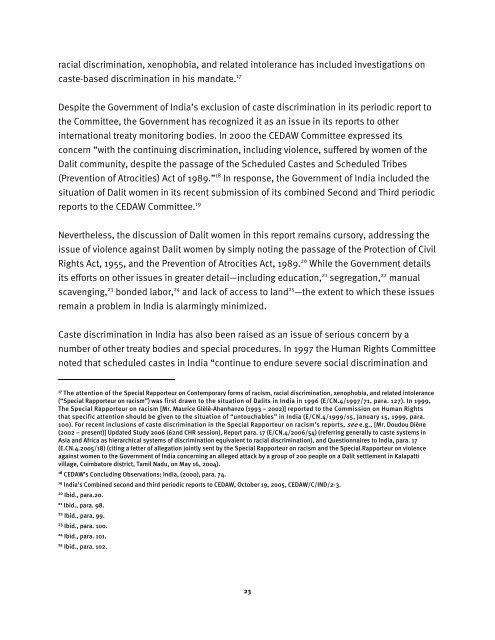Caste Discrimination against India's âUntouchablesâ - Human Rights ...
Caste Discrimination against India's âUntouchablesâ - Human Rights ...
Caste Discrimination against India's âUntouchablesâ - Human Rights ...
Create successful ePaper yourself
Turn your PDF publications into a flip-book with our unique Google optimized e-Paper software.
acial discrimination, xenophobia, and related intolerance has included investigations on<br />
caste-based discrimination in his mandate. 17<br />
Despite the Government of India’s exclusion of caste discrimination in its periodic report to<br />
the Committee, the Government has recognized it as an issue in its reports to other<br />
international treaty monitoring bodies. In 2000 the CEDAW Committee expressed its<br />
concern “with the continuing discrimination, including violence, suffered by women of the<br />
Dalit community, despite the passage of the Scheduled <strong>Caste</strong>s and Scheduled Tribes<br />
(Prevention of Atrocities) Act of 1989.” 18 In response, the Government of India included the<br />
situation of Dalit women in its recent submission of its combined Second and Third periodic<br />
reports to the CEDAW Committee. 19<br />
Nevertheless, the discussion of Dalit women in this report remains cursory, addressing the<br />
issue of violence <strong>against</strong> Dalit women by simply noting the passage of the Protection of Civil<br />
<strong>Rights</strong> Act, 1955, and the Prevention of Atrocities Act, 1989. 20 While the Government details<br />
its efforts on other issues in greater detail—including education, 21 segregation, 22 manual<br />
scavenging, 23 bonded labor, 24 and lack of access to land 25 —the extent to which these issues<br />
remain a problem in India is alarmingly minimized.<br />
<strong>Caste</strong> discrimination in India has also been raised as an issue of serious concern by a<br />
number of other treaty bodies and special procedures. In 1997 the <strong>Human</strong> <strong>Rights</strong> Committee<br />
noted that scheduled castes in India “continue to endure severe social discrimination and<br />
17<br />
The attention of the Special Rapporteur on Contemporary forms of racism, racial discrimination, xenophobia, and related intolerance<br />
(“Special Rapporteur on racism”) was first drawn to the situation of Dalits in India in 1996 (E/CN.4/1997/71, para. 127). In 1999,<br />
The Special Rapporteur on racism [Mr. Maurice Glèlè-Ahanhanzo (1993 – 2002)] reported to the Commission on <strong>Human</strong> <strong>Rights</strong><br />
that specific attention should be given to the situation of “untouchables” in India (E/CN.4/1999/15, January 15, 1999, para.<br />
100). For recent inclusions of caste discrimination in the Special Rapporteur on racism’s reports, see e.g., [Mr. Doudou Diène<br />
(2002 – present)] Updated Study 2006 (62nd CHR session), Report para. 17 (E/CN.4/2006/54) (referring generally to caste systems in<br />
Asia and Africa as hierarchical systems of discrimination equivalent to racial discrimination), and Questionnaires to India, para. 17<br />
(E.CN.4.2005/18) (citing a letter of allegation jointly sent by the Special Rapporteur on racism and the Special Rapporteur on violence<br />
<strong>against</strong> women to the Government of India concerning an alleged attack by a group of 200 people on a Dalit settlement in Kalapatti<br />
village, Coimbatore district, Tamil Nadu, on May 16, 2004).<br />
18<br />
CEDAW’s Concluding Observations: India, (2000), para. 74.<br />
19<br />
India’s Combined second and third periodic reports to CEDAW, October 19, 2005, CEDAW/C/IND/2-3.<br />
20<br />
Ibid., para.20.<br />
21<br />
Ibid., para. 98.<br />
22<br />
Ibid., para. 99.<br />
23<br />
Ibid., para. 100.<br />
24<br />
Ibid., para. 101.<br />
25<br />
Ibid., para. 102.<br />
23

















